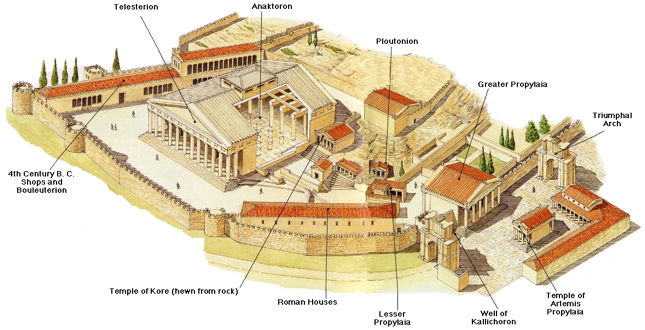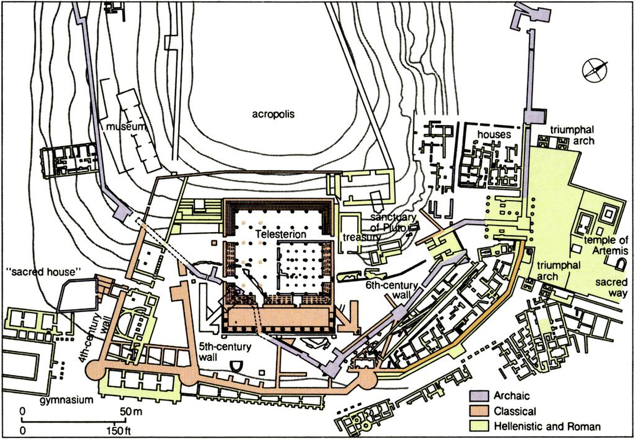Sanctuary of Demeter at Eleusis
Archaeological Development
In 1738 John Montague visited the site and noted that many sculptures had been destroyed by the Turks who had begun to inhabit the site. [1]
50 years before this, Sir George Wheeler had painted the ruins giving us an idea of what they looked like prior to this.[2]
Edward Clarke visited the site in 1803 and saw the statue of the Cargatid. He wanted to take it back to England but the statue was sacred to the locals, who believed ‘Saint Demetra’ protected their crops.
The myth told is that he attempted to take it away and got the statue as far as his ship, only for it to have returned by itself in the night.
When he finally got it on his ship, the entire vessel sunk on the journey back to England. It was recovered much later and the statue now lives in the Fitzwilliam Museum. The crops of the locals failed for years after Clarke took the statue. [3]
Since Clarke’s removal of the statue, Hobhouse remarked that ‘the remains of ancient Eleusis are now very insignificant; some small stones and pieces of rubbish standing upright,’ are all that is left. [4]
In 1812 the Society of the Dilettanti excavated the site and found the location of the Telesterion but at this point it had been buried under part of the village therefore making it impossible to excavate fully.
In 1882 Demetrios Philos engaged in a full excavation of the site, he was funded by the Athens Archaeological Society and was able to move the houses in the area of the Telesterion. However he was able to find little, meaning it is difficult to give real conclusions about the structure and organization of the site. [5]
Gods/Heroes
The practices were based on 2 goddesses; Demeter and Persephone.
Epithets & alternative names: Demeter Chloë (‘The Green’), Ceres .
Persephone/Kore.
Persephone was stolen by Hades, leaving Demeter to mourn her on earth. She disguised herself as an old woman and then sat by one of the wells in the city of Eleusis, until King Keleos’ daughter found her and took her to the Queen. Demeter became a nurse to her son Prince Demophon, she attempted to make him immortal by holding him over the fire until the Queen walked in on her setting fire to her son and made her reveal her true identity. After revealing her identity Demeter ordered the citizens of Eleusis to build her a temple, in which she hid for a year – leaving everywhere else in a perpetual winter and causing famine and many deaths. Eventually Zeus decided to intervene because people stopped sacrificing to him because they were dying and allowed Persephone to return to Demeter for half a year and spend the rest of her time in the underworld with Hades. [6]
This was a 9th century myth and by the 8th century Persephone had been established as the Queen of the Underworld.
Due to Persephone returning from the underworld, the religion was seen to propose the idea of being able to return from the dead, which is what made it so popular. It also promotes the idea of fertility, and nature, and the hopefulness of spring (when Persephone returned).
Ritual Activity
Sacrifice-
The rites were held in Demeter’s honour.
At the festival of Haloa the priestess would give offerings of food and drink as there were strictly no blood sacrifices. [7]
During the Thesmophoria, on the same day as the feasting the remains of rotten pigs were brought up from the snake-filled pits (given the name Megara), mixed with seeds and placed on the altar as an offering. According to Ruscillo, when using zoological evidence, the noise made by the bailers (no date for this festival) would have caused the snakes to regurgitate the piglets they had been fed earlier in the festival. [8]
Dedications –
The site itself was dedicated to Demeter, there was essentially a void of dedications to her in the third century, only a few in the fourth century with a few more from the first and second centuries BC. In the fourth century, over half of the dedications come from the city itself, and some even honour the officials instead of the goddess. [9]
Festivals-
The Eleusinian festivals focused on the fertility for both agriculture and humans.
March/April celebrated the festival of Chloia which honoured Demeter Chloë (‘The Green’). This was to mark the beginning of spring, and the growing of crops.
In Summer, it was Calamaia, a festival for the threshing of grain.
In August/September the Eleusinia festival was celebrated, intending to to give thanks to Demeter for the gift of agriculture. It was celebrated every four years and on a much grander scale.
October/November held the Proerosia, a pre-ploughing festival.
November/December was the month of Poseidon, in which the festival of Haloa was celebrated. It honoured Demeter and Dionysus and was exclusively for women. There was a strong focus on fertility with male and female genitalia made of dough and presented everywhere. The priestess would whisper sacred words to the participants – we do not know what they were because of the secretive nature of the festival. [10]
The Thesmophoria was one of the most widespread festivals in Greece and celebrated all over the Greek world. It lasted for 3-4 days and began with a procession from Athens to the sanctuary of Demeter. There was a day of fasting (nesteia) to represent the sadness of Demeter as the initiates would allow themselves to become targets of ritual mockery (aisechrologia), and then a day of feasting. There was strong fertility imagery here, and again the phallic symbols made of dough. The festival honoured the fertility of crops, humans and the status of citizen women. Again this was an exclusively female festival. [11]
Other-
The organization of the mysteries was the job of the Archon Basileus, who would be assisted by a paredros and four epimeletai. The religious parts were organized by the priests, with the highest priest being the Anaktoron who would officiate the initiation. The priestesses of Demeter and Kore were involved in all the ceremonies.
The mysteries themselves lasted over two thousand years from around 1450 BCE to 230 CE. [12]
Rules and Regulations
Pausanias 5.10.1 ‘Many are the sights to be seen in Greece and many are the wonders to be heard, but on nothing does heaven bestow more care than on the Eleusinian rites.’ The Eleusinian mysteries were exactly that, a mystery, therefore there was a strict level of secrecy which was expected to be upheld by all of the initiates. Anyone who revealed the mysteries/non-initiates who trespassed onto the sanctuary ground would be killed. The privacy of the Eleusinian mysteries was actually protected by the Athenian law under penalty of death. Two young boys were executed for sneaking in to spy on the mysteries and Alcibiades and Andokides were almost executed because they were believed to have disclosed secret content from the mysteries. Pagan authors respected the law, therefore did not write anything on the mysteries leaving us with limited sources.
Other Activities
Aristotle gave details about the initiation ceremony, it was supposed to be an emotional experience instead of a cerebral one of learning; ‘παθειν instead of μαθειν᾽ [13]. Therefore the experience was supposed to be spiritual instead of relying on the guidance of the senses.
The initiation was supposed to allow the individual to focus on their inner self, thus being protected by silence.
The initiation took place over nine days;
- DAY 1: The Archon Basileus summoned people in the Poikile Stoa for a formal proclamation. All could attend except for those who did not understand Greek and those who had committed murder.
- DAY 2: The mystai purified themselves by washing a piglet in the sea and then sacrificing it once back in the city.
- DAY 3: There were sacrifices in the Eleusinion with the help of the Archon Basileus. (We think, these details are uncertain).
- DAY 4: Named Askelpia in Epidauria was the day the cult of Asclepius joined the Eleusinian mysteries.
- DAY 5: A huge procession from Athens to Eleusis. Beginning at the Eleusinion, progressing to the Panathenaic way, past the agora and the Dipylon Gates, and then following the Sacred Way until they reached Eleusis. Those walking would be dressed in festival clothes, wearing crowns of myrtle wreaths and holding branches of myrtle tied with strands of wool called ‘bacchos.’
After crossing the bridge to the sacred way, they would tie a ribbon of saffron around their right hand and left leg. They would then drink a liquid named kykeon, the ingredients of which are unknown, but it was believed to contain a psychotropic element (possibly opium as poppies were associated with Demeter) which caused hallucinations.
- DAY 6/7: The secret second degree of the initiation ceremony took place and the myrtle wreaths were replaced by ribbon wreaths. We do not know anything after that.
- DAY 8: unknown.
- DAY 9: everyone would return home, in a very low-key procession. [14]
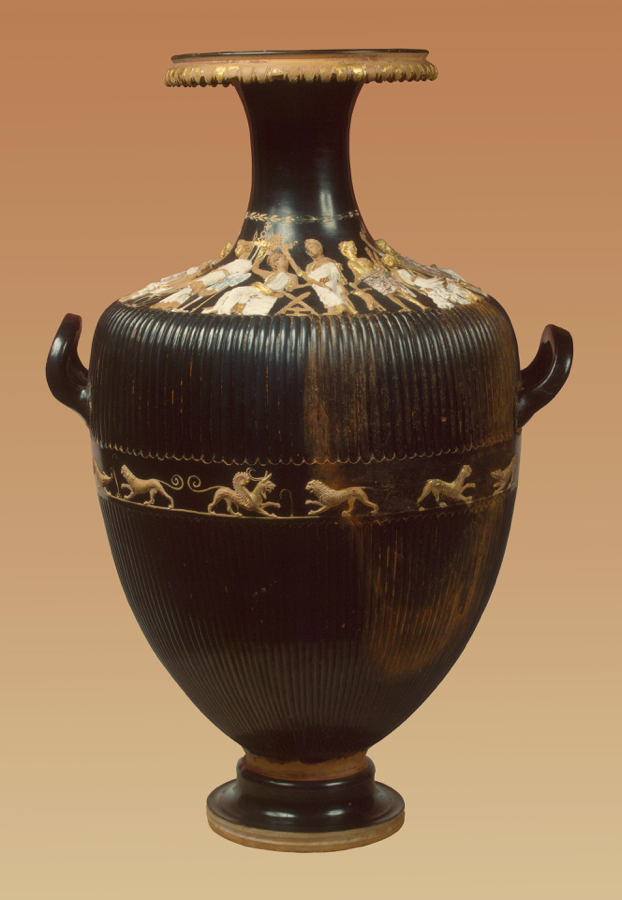
The polychrome hydra Regina Vasorum depicts the mystery rites. [15]
It shows the full myth, beginning with Demeter sitting on the Mirthless rock and Kore sitting in the underworld. It also shows the god Iacchus who leads the initiates to Eleusis. Trimptolemus and Athena are also on the hydra in order to show that Athens invites all Hellenes to join their festival. It ends with Demeter greeting Kore on her return home. [16]
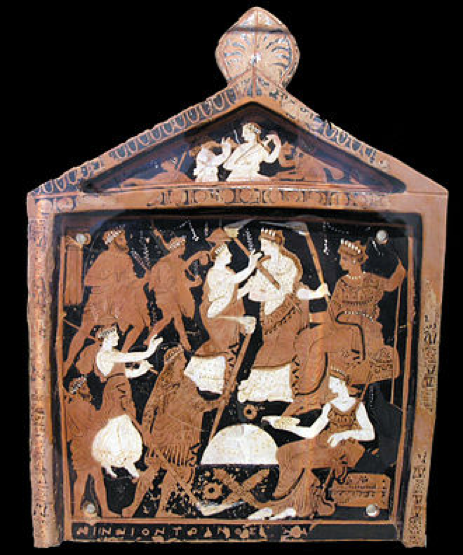
Ninnion Tablet, a votive plaque showing parts of the rites. [17]
Who used the site, and where did they come from?
Eleusis was a deme making up part of the Athenian polis. The Eleusinian festivals were therefore Athenian but open to all. (Depending on the festival, as previously specified some were female only attendance.)
It was also later used by the Romans such as Cicero who claimed that Athens had given nothing more divine or excellent than the Eleusinian mysteries.
Select Site Bibliography
M.B. Cosmopoulos (2015) Bronze Age Eleusis and the Origins of the Eleusinian Mysteries. (Cambridge: Cambridge University Press).
K. Clinton, edited by N. Mariantos & R. Hägg. (1993) Greek Sanctuaries – New Approaches (New York: Routledge).
J. C. Hobhouse, (1817) A Journey Through Albania and Other Provinces of Turkey in Europe and Asia. (Phildelphia: M. Carey and Son).
Homeric Hymn to Demeter – accessed 21/2/17 http://www.perseus.tufts.edu/hopper/text?doc=HH%202
G. Zuntz, (1971) Persephone. Three Essays on Religion and Thought in Magna Graecia. (London: Oxford University Press).
J. D. Mikalson (1998) Religion in Hellenistic Times (Los Angeles: University of California).
M.L. Keller,(2009) The Ritual Part of Initiation into The Eleusinian Mysteries, (Los Angeles: University of California Press).
Ross, (1955) Aristotle: Selections. (The Society for the Promotion of Hellenic Studies).
Hydra depicting the rites of Eleusis. https://www.hermitagemuseum.org/wps/wcm/connect/1341b63b-6c32-489b-a21f-ca565a10cef0/WOA_IMAGE_1.jpg?MOD=AJPERES&CACHEID=1341b63b-6c32-489b-a21f-ca565a10cef0
The Ninnion Tablet.
Site plan.
http://shelton.berkeley.edu/175c/Demeter/zEleusisPlan.jpg
Reconstructed site plan.
http://ulearnabroadingreece.net/AncientEleusis.jpg
Footnotes
[1] M. B. Cosmopoulos, (2015) pg 34.
[2] M. B. Cosmopoulos, (2015) pg 34.
[3] M. B. Cosmopoulos, (2015)pg 35.
[4] Hobhouse, (1817) pg 375.
[5] M. B. Cosmopoulos, (2015) pg 37.
[6] Homeric Hymn to Demeter & M. B. Cosmopoulos, (2015)pg 8-9.
[7] M. B. Cosmopoulos, (2015) pg 11-12.
[8] Zuntz, (1971) pg 79.
[9] J. D. Mikalson (1998) pg 260.
[10] M. B. Cosmopoulos, (2015)pg 11-12.
[11] M. B. Cosmopoulos, (2015) pg 4.
[12] M.L. Keller,(2009) pg 28.
[13] Ross, (1955) fr 15.
[14] M. B. Cosmopoulos, (2015) pg13-15.
[15] Hydra depicting the rites of Eleusis. https://www.hermitagemuseum.org/wps/wcm/connect/1341b63b-6c32-489b-a21f-ca565a10cef0/WOA_IMAGE_1.jpg?MOD=AJPERES&CACHEID=1341b63b-6c32-489b-a21f-ca565a10cef0
[16] K. Clinton (1993) pg 115.
[17] The Ninnion Tablet.
[18] site plan.
http://shelton.berkeley.edu/175c/Demeter/zEleusisPlan.jpg
[19] reconstructed site plan.
http://ulearnabroadingreece.net/AncientEleusis.jpg
Location
Eleusis Greece. The sanctuary is located roughly 20 km from Athens, overlooking the Eleusis bay and the island of Salamis. It was next to a hill and surrounded by fertile lands and fields which allowed the animals to graze and crops to be grown easily.
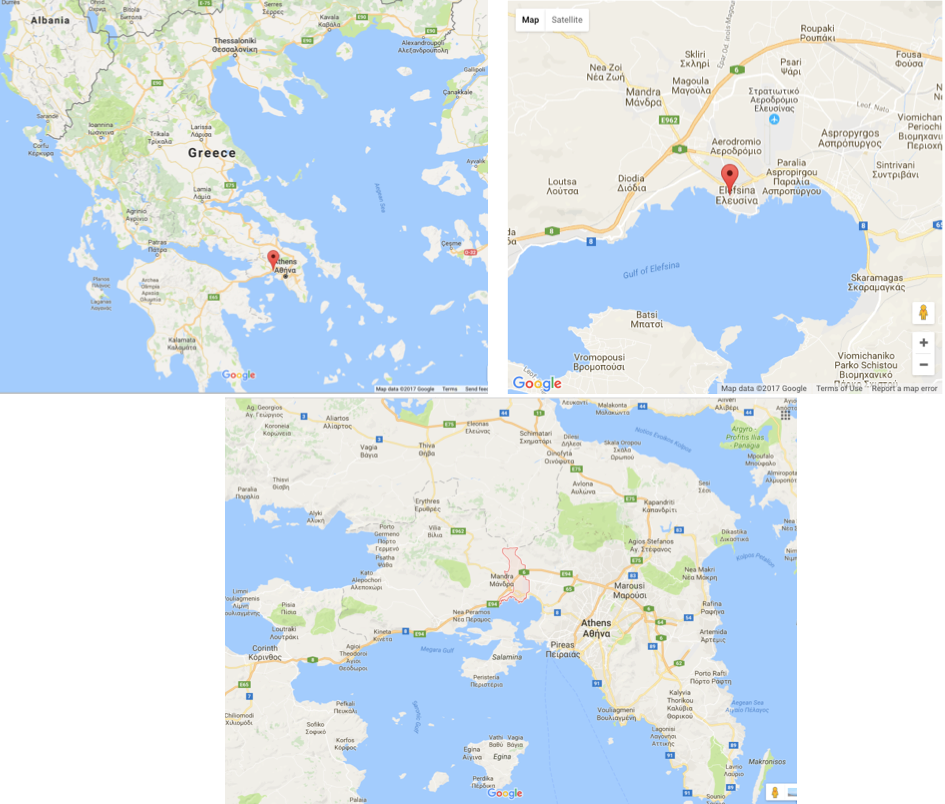
Site Plan
